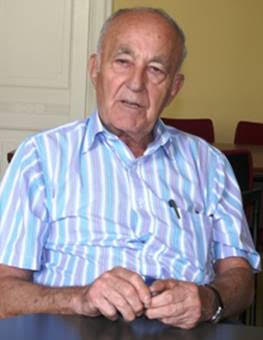
THE VOICE OF INTERNATIONAL LITHUANIA
|
VilNews has its own Google archive! Type a word in the above search box to find any article.
You can also follow us on Facebook. We have two different pages. Click to open and join.
|
Author Archive
![]()

Lithuanian Prime Minister Andrius Kubilius said his country will join Europe’s common currency when the euro area is ready for expansion, signaling that Europe’s sovereign debt crisis may alter his government’s euro adoption plans.
Lithuania will apply for the euro “when we’re ready and when the euro zone is ready,” Kubilius said in a radio interview with Lietuvos Radijas today. “The euro remains our strategic goal. Nevertheless, we’d like to see a clearer and more stable situation in the euro zone at the time when we adopt the euro.”
Kubilius dodged giving a specific target date as to when Lithuania will switch currencies, evading previous statements that the government aims to join the euro in 2014. He said the country will meet all the requirements for euro adoption next year, including the inflation target as declining oil prices help curb consumer-price growth.
Europe’s debt crisis is cooling Baltic enthusiasm for euro entry.
- Bookmark :
- Digg
- del.icio.us
- Stumbleupon
- Redit it
- Posted by - Comments (0)
“The mass graves of Tuskulėnai”
A series of articles in 6 parts
TODAY PART 3 OF 6:
Bishop Vincentas Borisevičius

The Soviet repressions against the citizens of our country did not exclude members of the Church. In fact the members of the Church were prime targets. Bishop Vincentas Borisevičius is an example of these repressions. A Holy man of great compassion, he was also a man of great honor and courage.
By Vincas Karnila, Associate editor
vin.karnila@VilNews.com
To read more, go to our SECTION 10
- Bookmark :
- Digg
- del.icio.us
- Stumbleupon
- Redit it
- Posted by - Comments (0)
|
The Soviet repressions against the citizens of our country did not exclude members of the Church. In fact the members of the Church were prime targets. PART 3 OF 6 BISHOP VINCENTAS BORISEVIČIUS |
BISHOP VINCENTAS BORISEVIČIUS

Photo property of the Lithuanian Central Archives.
All rights reserved.
Telšiai Theological Seminary Rector Vincentas Borisevičius. Telšiai
He was born 23 November 1887 in Vilkaviškis County, Paežeriai Rural District, Bebrininkai Village. In 1909, he graduated from Seinai Seminary. He studied at the University of Fribourg (Switzerland) from 1909 to 1913. In 1910, Borisevičius was ordained a priest, did pastoral work, and actively participated in public activities. Between 1922 and 1926 he taught at Gižai Seminary (Seinai Diocese). Between 1927 and 1940 he was a professor and rector at Telšiai Seminary. In 1940, he was ordained titular bishop of Lysia by Pope Pius XII and appointed auxiliary bishop to Telšiai Bishop Justinas Staugaitis. After the death of Bishop Staugaitis in 1944, Borisevičius became the diocesan bishop of Telšiai.

Photo property of the Lithuanian Central Archives. All rights reserved.
Group Seinai seminary students: The future bishop Vincas Borisevicius
(third row, second from left). About 1908.
Priest Juozas Montvila (second row, second from right) was a passenger on the Titanic.
He died in 1912 when the ship sank in the Atlantic Ocean.
After the Soviet occupation of Lithuania in 1940, Borisevičius protested against the restrictions of the rights of the Church and the persecution of priests and believers. During the Nazi occupation of Lithuania, the Bishop helped Jews hiding in the villages and parishes of Telšiai County. After the liquidation of the Telšiai Ghetto, he himself gave refuge and hid Jews who managed to escape from the ghetto. After the second Soviet occupation of Lithuania, on 18 December 1945, Borisevičius was arrested and detained in the internal prison of the NKGB–MGB. He was charged with anti-Soviet activities and contact with partisans. Attempts were made to recruit him to serve the Soviets.

Photo property of the Lithuanian Central Archives.
All rights reserved.
Theological Seminary Rector Monsignor Borisevičius (left)
and seminary professor of Canon George Galdikas (right). Telšiai.
After unsuccessful efforts to break him, he was released and given time to make up his mind. In the end the Bishop refused to cooperate with the Russians and on 3 January 1946 wrote the following letter to the leadership of the NKGB–MGB:
“I declare that to be an informer is incompatible with me as a person and as a bishop, it is incompatible with my conscience, so I categorically refuse to be the one,”
With this letter Borisevičius signed his own death sentence.


Photo Property of the Lithuanian Central Photos property of the Lithuanian Special Archives. All rights reserved.
Archives. All rights reserved
On 5 February 1946, he was arrested and on 28 August charged by the Military Tribunal of the Lithuanian SSR MVD Troops under Article 58-1a of the Criminal Code of the Russian Soviet Federal Socialist Republic (RSFSR) with supporting participants of the armed resistance against the Soviets, preaching anti-Soviet sermons and being in possession of prohibited literature. His sentence was death by execution. The sentence was carried out on 18 November 1946 in the internal prison of the NKGB–MGB. The Bishop was shot in the head. The repressive structures of the Soviet occupational government kept the circumstances, place, and time of death of the Bishop hidden.

Photo property of the Lithuanian Central Archives. All rights reserved.
Theological Seminary Rector Vincas Borisevicius (center), seminary professors
Simaitis Anthony (left) and Peter Lygnugaris (right). Telšiai
In 1990, the re-establishment of independence in Lithuania provided an opportunity to investigate the documents of the former KGB archive. In 1994, the State Security Department of the Republic of Lithuania identified a mass grave of people that had been within the grounds of the former Tuskulėnai Manor. That same year, archaeological excavations and exhumation of the bodies began. The body of Bishop Borisevičius was found and identified in mass grave No. 26. On 27 September 1999, a formal reburial ceremony took place and the body was laid to rest in the crypt of Telšiai Cathedral.

Photo property of the Lithuanian Central Archives. All rights reserved.
Bishop Vincas Borisevicius with parishioners after a First Communion ceremony.
Telšiai in the twentieth century. 3-4 decade.
In 1991, the cause for the canonisation of the Bishop was initiated. By decree of the President of the Republic of Lithuania, Borisevičius was posthumously awarded the Grand Cross of Commander of the Order of the Cross of Vytis in 1999, and in 2003, with the Life Saving Cross.


Order of the Cross of Vytis

Life Saving Cross
KGB – rus. Комитет Государственной Безопасности – Lith. Valstybės saugumo komitetas – Committee for State Security [of the USSR]
MGB – rus. МГБ, Министерство государственной безопасности – Lith. Valstybės saugumo ministerija – Ministry of State Security [of the USSR]
MVD – rus. МВД, Министерство внутренних дел – Lith. Vidaus reikalų ministerija – Ministry of Internal Affairs [of the USSR]
NKGB – rus. НКГБ, Народный Комиссариат Государственной Безопасности – Lith. Valstybės saugumo liaudies komisariatas – People’s Commissariat for State Security [of the USSR]
NKVD – rus. НКВД, Народный комиссариат внутренних дел – Lith. Vidaus reikalų liaudies komisariatas – People’s Commissariat of Internal Affairs [of the USSR]
PRIBVO – rus. ПРИБВО, Прибалтийский военный округ – Lith. Pabaltijo karinė apygarda – Baltic Military District
Look for the next article
Part 4 of 6
THE EXECUTIONERS
Dear readers
WE NEED YOUR HELP
Dear VilNews readers, we need your help. As we have said, the victims that were executed in the NKGB–MGB internal prison in between 28 September 1944 and 16 April 1947 were buried in secret mass graves in the territory of the Tuskulėnai Manor. These victims have been found, their bodies recovered, given the dignified burial they never received and their souls have been blessed by a Holy person of the religion the worshipped.
26 May 1947, following the order of the Presidium of the Supreme Council of the USSR, the death penalty was abolished.
On 12 January 1950, the Presidium of the Supreme Council of the USSR passed a decree re-instating the death penalty. Between October 1950 and July 1952, 182 people sentenced to death were executed at Vilnius NKGB–MGB internal prison.
Their place of burial is still not known.
After July 1952 to 1961 executions continued pursuant to the 1926 Criminal Code Article 58 of RSFSR.
The burial place of these victims is still unknown.
The 1926 Criminal Code Article 58 of RSFSR was terminated in 1961 but executions continued.
The burial place of these victims is still unknown
Dear readers we would like to find where these people are buried, recover their bodies, give them the dignified burial they never received and have them blessed by a Holy person of the Religion they worshipped.
This is where we need your help. The NKVD and NKGB–MGB officers that oversaw these executions are now all dead. What ever records and documents which still exist are most likely locked away in a vault somewhere in the Russian Federation and it would seem highly unlikely that anyone in the Russian Federation would be kind enough allow access to these documents and records so that we could find out the location of the burial sites or simply tell us where these people are buried.
We know that there are people out there that know the location of some of these burial sites. Maybe it is a person that processed the documents, maybe it is some one that was just a rank and file soldier that was ordered to drive the truck that transported the bodies or was ordered to dig the trenches for the graves, maybe it is a colleague of one of these people or maybe it is the bartender that heard some of these people talk of it one night. The possibilities are endless.
Maybe none of these people with first hand knowledge of the burial sites are still alive. In that case we are sure that there are people out there with second hand or even third hand information. To have first hand knowledge of these executions would weigh very heavily on any civilized person’s heart and it is very possible that after carrying this weight inside them for many years they finally felt the need to free themselves from this burden they carried inside and told some one.
If you have any information at all, any information of any kind – Please tell us.
It is not important to us how you know, who it was, what they did or who told you.
None of this is important.
The only thing that is important is that we find where the executed people are buried.
This is all we care about.
What we want to do is best explained in the words from Bronius Eiva’s farewell letter he wrote to his wife while waiting his execution while in the prison of Ukmergės Peoples Commissariat for Internal Affairs.
“Please find out when I was shot or hanged and where they bury me.
Dig me up and take me to Šeta cemetary.”
This is all we want to do – Find where they are buried, dig them up and then give them a proper burial but we can only do this with your help.
All information will be kept strictly confidential
We are not concerned with who or what
We are only concerned with where these people are buried
If you have any information of any kind please contact:
The Memorial Complex of Tuskulenai Peace Park
Žirmūnų Gatvė 1F,
LT-09239, Vilnius
Lithuania
Telephone: +370 5 275 1223
E-mail. tuskulenai@genocid.lt
You can also contact me at vkvilnius-tuskulenai@yahoo.com
We sincerely thank you for your help.
Su pagarbe
Vincas Karnila
- Bookmark :
- Digg
- del.icio.us
- Stumbleupon
- Redit it
- Posted by - Comments (0)
Kestutis J. Eidukonis about Lithuania year 2012
Not all civil servants
are crooks or fools

By Kestutis J. Eidukonis, CEO VilNews
kestutis.eidukonis@VilNews.com
I have been coming and observing life in Lithuania for almost 20 years and would like to offer some observations and comments on life in Lithuania according to Lithuanians. These are little gems I have picked up talking to Lithuanian friends and relatives and my observations on these so called "TRUTHS". I don't vouch for the accuracy of these claims they may or may not be true, but perceptions are often just as corrosive as reality.
Truth according to Lithuanians:
1. It doesn't matter who is in power - nothing will change. Voting is useless - I have no one to vote for anymore. Everyone I voted for in the past has disappointed me.
Apathy is a useful tool for enemies of the country. This is a sure sign of defeat.
- Bookmark :
- Digg
- del.icio.us
- Stumbleupon
- Redit it
- Posted by - Comments (4)
Kestutis J. Eidukonis about Lithuania year 2012
Not all civil servants
are crooks or fools

By Kestutis J. Eidukonis, CEO VilNews
kestutis.eidukonis@VilNews.com
I have been coming and observing life in Lithuania for almost 20 years and would like to offer some observations and comments on life in Lithuania according to Lithuanians. These are little gems I have picked up talking to Lithuanian friends and relatives and my observations on these so called "TRUTHS". I don't vouch for the accuracy of these claims they may or may not be true, but perceptions are often just as corrosive as reality.
Truth according to Lithuanians:
1. It doesn't matter who is in power - nothing will change. Voting is useless - I have no one to vote for anymore. Everyone I voted for in the past has disappointed me.
Apathy is a useful tool for enemies of the country. This is a sure sign of defeat.
2. All politicians are crooks. They only go into parliament to steal money - Very common feeling. When asked to explain - most Lithuanians are able to point out which parties are financed by whom or what. Strangely enough, they will always point out one or two politicians whom the believe are honest and would do a good job "if the parties and the "real rulers" would only let them.
I don't believe ALL members of parliament are fools there are some good ones.
3. There are no honest news sources.
With the exception of LRT (Lithuanian Radio & Television - run by the government) radio PUKAS run by a reform minded patriot, ( I would like to include VilNews) most of the other media has been bought by - name a country... In reality it is hard to find anything positive about any government official in any news media. LRT at least doesn't smear people or ridicule them. Strangely enough some obviously corrupt and foreign influenced politicians are given a pass. This leads people to tune out and discount most things they hear or read. It is also believed that politicians are able to "buy" either favorable or at least neutral coverage. The Lithuanian news media is not held in high regard by most citizens.
4. The government offices are full of useless friends and relatives of politicians who do nothing but put up obstacles for "honest" citizens trying to make a living. The Lithuanian golden rule applies. In the rest of world "he who has the gold makes the rules". In Lithuania "he who makes the rules gets the gold".
My observation - not all civil servants are crooks or fools. I have met and know some good people who are dedicated and do a good job under trying circumstances.
5. The government offices are filled with ex KGB officers.
Lot of truth to this one. Why don't we just fire them?
6. The government, especially the prosecutors and judiciary is corrupt to the core. There is no justice in Lithuania. We constantly see people "getting away with it" in the news. This reinforces the "there is nothing good, there is no justice" inLithuania, school.
There has got to be some honest ones.
7. Things were better in the Soviet times. We had jobs and things got done properly.
When pressed everyone agrees that - yeah we had money but there was nothing to buy - ah but vacations were free etc. What happened to the feeling and spirit of 1989-91?
8. People are leaving Lithuanian not necessarily for economic reasons - but because they do not see a possibility of changing Lithuania for the better.
This one is very true.
As a former military "propaganda" analyst, I recognize that for propaganda to be effective the lies must be hidden by a cloak of truth. Wildly inaccurate propaganda or "disinformacija" cannot succeed, but I must admit that whoever has been conducting this campaign has succeeded beyond all expectations. They have turned the words "some" into "all" as in all politicians are corrupt.
I would like to offer some unsolicited solutions
As usual in any of my articles I also would like to offer some unsolicited solutions. My Lithuanian friends also believe that us US Lithuanians don't know or understand anything but here goes - Start with a citizens movement. Lithuanian Patriots need to come together on a number of fronts. Don't go start any more parties. The referendum process can work very well in this country but we need thousands of involved dedicated citizens to work together. Not just complain, but do something. The internet is a powerful tool.
1. Size of the Seimas needs to be cut. There was a referendum called for on this - but thanks to a lack of support it failed to garner the required signatures. It needs to be resurrected. The size of the Seimas needs to be cut and their salaries cut. The Seimas needs people who are their to do good for their country - this means sacrifice - not to enrich themselves or their friends and family. Paralysis through analysis. Remember what the Liberum Veto did to the Grand Duchy of Lithuania. Distraction through corruption and scandal. I do admit that the Seimas has also done a lot of good, but its reputation is not good.
2. Voting for political party tickets need to be abolished. Vote for individuals not parties. Now I have to elect the trash along with the "few good" candidates. Candidates can still belong to parties, but let the voter chose which individual will do a good job and if a party has good candidates they will be elected. Presently the election is used to reward friends relatives and other useful idiots. We just have to look at who is there now. We have some very good people and a lot of people who do not have what it takes. The same goes for our ministers. Some of them are in over their heads.
3. Lets expose who runs which news media. I have no problems with their opinions - but let us know who is backing them. I think some are definitely run by hostile intelligence services.
4. Government size needs to be cut. Let us use a zero based start. Every department has to justify its existence and its budget. Let us eliminate all political appointments, ex KGB officials and anyone who has been involved in any form of corruption. Lithuanian cannot support the size of the government it has now - this problem will be even worse once the EU is forced to tighten its belt.
5. Let us start a school for prosecutors preferably run by a person who is seen as totally trustworthy by society. Staff this school with the most honest teachers, staff it with the brightest, bravest and best youth we have. After graduation replace ineffective and corrupt prosecutors without mercy. The same goes for the Judiciary. Judges should come from the best and bravest prosecutors.
6. Let us also examine our Intelligence services. What do they know about who or what has infiltrated Lithuanian society. They may have legitimate reasons for not exposing these people, I would be curious to know what those reasons are. According to one very reliable source there are over 200 known "foreign agents of influence" working in Lithuania are any of them working in the Lithuanian Intelligence Service? Do our intelligence services know who they are? These people are very well financed and have gotten imbedded in the highest levels of society and government. There are forces at work who want to destroy Lithuania. These forces are well funded and brilliantly led. They have co-opted people in the media and non-governmental organizations to willingly or unwillingly do their bidding. Lithuanians deserve better, but they need to get awake and see what has happened to their country. Is this the country the Lithuanian partisans fought and died for? Is this the country people went to Siberia for? Is this the country we want for our children and grand children?
- Bookmark :
- Digg
- del.icio.us
- Stumbleupon
- Redit it
- Posted by - Comments (0)
In focus today: VilNews Section 21:
Lithuanian food
traditions since the
Grand Dukes
Prie lietuvių stalo – at the Lithuanian table
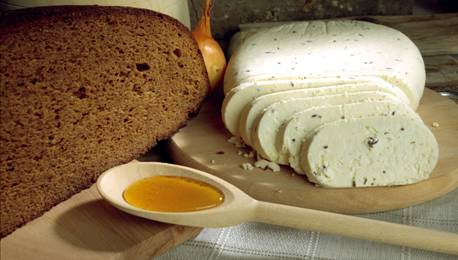
Text: Vin Karnila, Associate Editor
vin.karnial@VilNews.com
Sveiki garbingi skaitytojai,
Lithuania is steeped in traditions. It would be difficult to think of any part of daily life, family events or holidays where age old traditions are not practiced. Included in these are the time honored traditions that are practiced at the table. Yes, even sitting at the table to enjoy your meal is something that involves traditions practiced for generations by Lithuanian people all over the world.
- Bookmark :
- Digg
- del.icio.us
- Stumbleupon
- Redit it
- Posted by - Comments (0)
Lithuanian food traditions
since the Grand Dukes
Prie lietuvių stalo – at the Lithuanian table
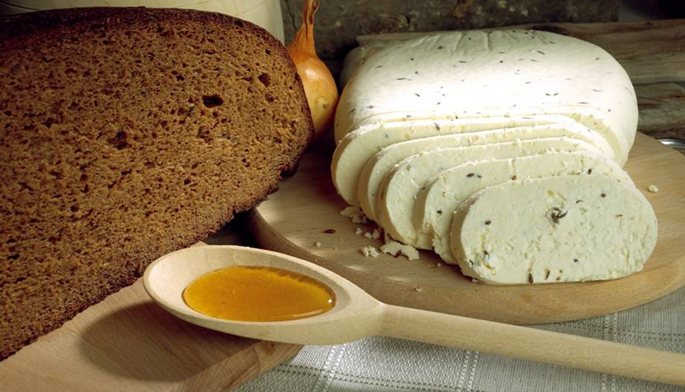
Text: Vin Karnila
Sveiki garbingi skaitytojai,
Lithuania is steeped in traditions. It would be difficult to think of any part of daily life, family events or holidays where age old traditions are not practiced. Included in these are the time honored traditions that are practiced at the table. Yes, even sitting at the table to enjoy your meal is something that involves traditions practiced for generations by Lithuanian people all over the world.
To start, there is the order of seating. The father sits at the end of the table. Now the end he sits at is important to note also. He sits at the end of the table that is near the wall not the end that faces the open room or the door. The eldest son sits at the father's right, while the other men sit next to the son along the wall. Women sit across from the men and the mother sits at the opposite end from the father. This traditional seating is maintained especially during holidays, when the entire family gathers together.
Now the question arises about the seating when the grandparents are at the table also. In this case it is customary that the father of the man of the house would take the position at the end of the table near the wall and his son (the man of the house) would then sit to his right.
Here is another tradition that I still see happening regularly. This involves an unmarried lady regardless of her age. She can be four or forty four it doesn’t matter. Very often at big get-togethers the hosts need to borrow tables, chairs and benches to accommodate all the guests. As a result the seating can be a little cramped, which is really no problem and adds to the friendship of the occasion. What happens is one of the little girls will want to sit at the table so she will squeeze her way onto the end of a bench at the corner of the table. Upon seeing this, the married ladies will throw their hands up in the air and shriek in horror. There is then a mad scramble and this confused little girl will be thrown between two of the married ladies and a married lady will take the place at the corner of the table. The by now very confused little girl will sit there with a very perplexed look on her face trying to figure out what the big problem was. It is then explained to her that if an unmarried lady sits at the corner of a table she will be cursed and never will marry. As I said, I see this happening to this day. To see the whole thing unfold can be quite entertaining.
With all the wonderful food that has been prepared, still the most important of all is the Bread. For Lithuanians bread is the most important of all food. It is a part of Lithuanian tradition and culture and is a symbol of life itself. This is why the Bread is placed in the most honorable place on the table which is right in front of father. The meal starts with the slicing of Bread by the father and this is done following tradition.
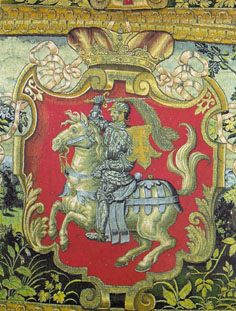
Father slices and passes the bread with great respect. The first slice, a corner of the bread is given to the eldest, married son, with wishes that his firstborn will be a son. Each member of the family takes a slice of bread directly from father's hand and places it respectfully on the table. Notice that the tradition is that the father takes the bread in his hand and places it in the hand of the others. While passing food to others at the table with your hands in some corners of social etiquette would draw gasps of table manners’ shock, for Lithuanians this is a symbol of great respect and love. The father is passing the bread, the symbol of life, from his hand to yours. I don’t mind telling you and I am not embarrassed to say that every time I sit at a table and watch this symbolic gesture take place I am almost overcome with emotion. It is truly one of the most beautiful of traditions in its symbolism.
The remaining, unsliced piece of bread remains on the table, with the cut end facing the most important corner of the house (whatever corner the family feels is the most important corner) or is facing the sun. The cut end of the bread was not placed facing the door because it was believed that this would make the bread angry. I must say that no one has ever explained to me exactly what would happen if the bread got angry about having its cut end pointed at the door but considering the importance bread plays in Lithuanian traditions and our daily lives it’s best we point it in the correct direction so we don’t find out.
This next tradition concerning bread is absolutely essential to abide by.
The bread IS NOT to be placed upside down on the table. I can guarantee that if you do this YOU WILL hear about it. The reason being is that placing bread upside down on the table is a serious desecration and for that the bread's vengeance will appear as a death in the family.
Another important tradition for the respectful handling of bread is that it is not allowed to break a slice with one hand. It takes both hands to earn bread so also it should be broken with two hands.
This tradition works great to get the kids to practice better table manners and handle their food more carefully. If you drop a piece of bread on the floor you must pick it up off the floor, kiss it and then eat it. It doesn’t matter how big or small the piece is, this tradition must be followed. Oh yes, I remember this one. This was probably the number one thing that got me to use better manners at the table.
Now one more piece of advice regarding bread at the table. How many of us have used a small piece of bread to mop up some of the remaining gravy or sauce off our plate? I openly confess to this practice and it’s a very practical and tasty way to enjoy the remaining sauce and at the same time you are helping clean the dishes. In fact one of the pleasant parts of sitting down to enjoy a wonderful Italian pasta dinner is using a piece of fresh and oh so delicious Italian bread to get every last drop of tasty tomato sauce. Growing up in a mostly Italian neighborhood I can tell you that this is common practice and is accepted and even encouraged. However when you are seated at a Lithuanian table, bread is never and I repeat NEVER used to clean up sauce off the plate. Weather you hold the bread in your hand to do it or break off a small piece and then use your fork, bread is not a tool to clean your plate and bread is not an eating utensil. The tradition is that bread is eaten from your hand and is the practice that should be followed at the table.
Should a visitor arrive when the family is at table, the visitor greets the eaters
with "skanaus" (bon appétit). If father answers "prašom" (you are welcome), it means do join us at the table. However if the answer is "ačiū" (thank you), the visitor is not invited to join in the eating. If invited to join the family at the table, a visitor from far away is either seated next to father or in his place. A “beggar” is seated at the other end of the table, near the door. Please allow me to add something to this. If you are visiting a Lithuanian family, that still follows traditions, and you are invited to sit at the father’s place, you are being paid a great honor. Be sure you thank your hosts most graciously.
Now here comes another Lithuanian tradition – The tradition of accepting or declining. When offered something you MUST at first politely decline. To accept at the first offering is considered extremely rude. The host MUST then ask offer again. For the host to not offer a second time is considered extremely rude. You should then again politely decline the second offer. The host should then offer again for a third time. After the third offer you can then graciously accept. If after the third offer you still politely decline then it is accepted that you really do not and/or can not accept the offer. Hence the tradition of asking three times.
An unexpected visitor was always graciously received and even if the family was not prepared to eat yet, food was soon set out. It usually consisted of traditional sausages, curd cheese, honey, eggs and homemade beer. To be polite, the visitor did not eat or drink until the host urged him to do so. This urging, when done immediately after the food and drink are put on the table, is a true sign of Lithuanian hospitality.
If the table is loaded with all kinds of goodies but there is no urging to partake in the food, it is said, "there was plenty of everything, but there was no urging at all from the host".
In earlier times, the host would fill his glass with beer or mead, and greet guests with these words,
"to your health dear brothers, drink and be merry. Be healthy, dear visitors". He then sprinkled a few drops on the floor so that everyone would be in good health and then drank from his glass. The spilling of a few drops of your drink is actually done as a “gift to the gods” (of drink). Refilling his glass again he would then pass it to the guest. If everyone shared the same glass, each one greeted each other with these words, "be healthy", and answered with "to your health". The glass was sent around the table from the right side because spring seeding was done with grain sprinkled to the right side, so drinks also go to that side. This tradition still continues today.
Lithuanians are known for their hospitality. They like to entertain and be entertained. Expecting guests they go all out preparing all kinds and amounts of delicacies. The hosts appreciate this statement, "there was plenty of everything, the only thing missing was bird's milk".
Guests preparing to go, thank, saying "thank you for the delicious cake, strong beer. Today we ate and drank yours, next time we'll drink mine". The host answers, "to your health".
There is another belief that the family cat, when she washes her face with her paw is telling you that guests are coming. The guests will come from the direction to which the cat is facing. Another arrival is forecast by cutlery falling on the floor, if a knife or spoon falls, a male guest is on his way, if a fork falls, expect a female guest.
So the next time you are invited to sit at the table of Lithuanians, take a moment to observe how many of these traditions are still being followed. Or – Maybe you can add some of them to your table?
- Bookmark :
- Digg
- del.icio.us
- Stumbleupon
- Redit it
- Posted by - Comments (0)
Our moms’
Lithuanian recipes
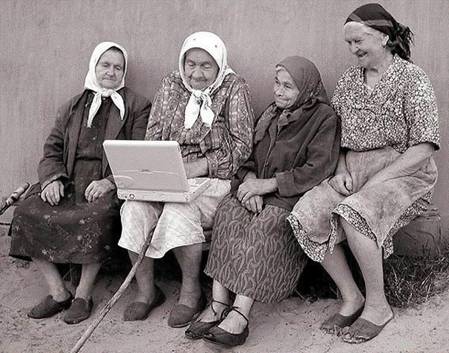
Our moms’ Lithuanian recipes is on Facebook. Click HERE to find it!
In 2011, a few of first generation Lithuanians from the Hartford Connecticut area in USA started posting on internet that they'd like to share some recipes that they grew up with. Many of these recipes may have been stored in someone's head and not written down, and the group wanted to make these recipes and food history from their beloved homeland at the Baltic Sea available also for future generations.
The group’s vibrant Facebook Page has till now collected over 1,000 members!
- Bookmark :
- Digg
- del.icio.us
- Stumbleupon
- Redit it
- Posted by - Comments (6)
Our moms’
Lithuanian recipes

Our moms’ Lithuanian recipes is on Facebook. Click HERE to find it!
In 2011, a few of first generation Lithuanians from the Hartford Connecticut area in USA started posting on internet that they'd like to share some recipes that they grew up with. Many of these recipes may have been stored in someone's head and not written down, and the group wanted to make these recipes and food history from their beloved homeland at the Baltic Sea available also for future generations.
The group’s vibrant Facebook Page has till now collected over 1,000 members!
The people behind the page is very interested in recipes that they can share with all interested in their Lithuanian background. Even if the old written recipes aren't legible anymore, you are asked to post photos of them. They will help you decipher or translate them, and get them posted so all can all enjoy them!
If you remember eating something Lithuanian as a kid and can't remember what it's called, post a description of it. Someone will likely know what it is and can post the recipe.
If you don't have recipes to post, join the Group and enjoy the cuisine and discussions. Try making something and let them know how it came out. They will also help you with trouble shooting.
Many of these recipes differ from family to family, so it is very interesting to see more than one post of the same recipe.
|
|
Our Moms’ Lithuanian Recipes was started by Ellen Petkaitis Carmichael (1961-2011) Ellen Petkaitis Carmichael was the driving force behind Our Moms' Lithuanian Recipes. Sadly, she died in a traffic accident just months after she started this success page, which now collects food-interested people with Lithuanian origin worldwide. We reproduce below the letter she wrote to VilNews when she introduced the Facebook Page in early 2011.
|
|
Ellen was born on December 21, 1961, Manchester, Connecticut, USA. She lived in West Hartford, Connecticut. Rest in peace, dear Ellen, you did a tremendous job for Lithuanian heritage!
|
|
Written by Ellen Carmichael in April 2011
ALL LITHUANIAN FOOD LOVERS FROM EVERYWHERE ARE WELCOME!
I remember my young days standing in my mother Ramute and aunt Danuteʼs kitchens watching them cook the food they had grown up with in Lithuania. Always busy, rushing around with purpose. Interesting, that they never had any cookbooks! It was always “a little of this, and a little of that”. But it always came out delicious. It wasnʼt until years later that I became interested in cooking the cuisine myself. When I asked my mother for her recipes, she said they are all in her head. So I started to write things down as she was cooking, and was later able to sit down with her and pick those recipes out of her brain and put them down on paper. Still, pinning her down on exact amounts of ingredients was a challenge. Interestingly, even though my Aunt Danute and my mother were sisters, their cooking was slightly different. Was it because neither of them wrote how they cooked things down; thus changes inevitably evolved? Probably. Iʼve noticed that as people post recipes for the same food in OMLR, they are all slightly different, but have the same basic ingredients. Thatʼs why I encourage people to post their recipes even if a recipe for that particular dish is already posted.
Where are all the Lithuanian Recipes?
I was curious why there arenʼt a larger number of Lithuanian cookbooks written in English. Certainly not nearly as many as for other foreign cuisines. It then occurred to me. For example, many of the Lithuanian immigrants came to the US during hard times, such as during the second world war. They escaped from Lithuania with only the clothes on their backs and the meager supplies they could carry. I think cookbooks were not a priority when they had to leave. My mother confirmed that was the case when she left Lithuania in 1942. They were almost trapped in the bombing and the fighting that took place between the Germans and the Russians and were forced to leave on foot. They lived on potatoes, onions and whatever farmers gave them while on the run into Germany. They certainly learned how to be creative with potatoes. When
finally in the United States, English was not their first language,
so if they did write some things down, it was in Lithuanian.
How OMLR got started
My cousin Paul posted onto his Facebook page a wonderful picture he found on the internet while searching for various Lithuanian recipes, and he commented: “Blogging about her Kugelis recipe no doubt”. That Facebook conversation turned into one where we reminisced about some of the stuff we ate as kids and I asked Paul if he has some of his mother’s (Danute’s) recipes, and he said not in electronic form. Then Paul’s friend Vida posted that she’d like to get some of Danute’s recipes too. Cepelinai, Napoleonas Tortas, koldunai, bacon buns were reminisced about in that thread. Vida suggested we start a FB page; I volunteered and got it started right away, using Paul’s posted picture as the profile picture. I wish I could give someone credit for that photo, but I have no idea where it came from and couldn’t find it again on the internet. I expected ten, maybe fifteen members to join. Pretty much only people that knew us. But much to my delight, it’s growing and there are members from all over...Australia, Switzerland, Lithuania, Canada, UK, all over the USA and probably more.
Troubleshooting with others
One thing that makes this site unique and especially useful for Lithuanian recipes, which do vary so much from person to person, recipe to recipe, is that we have an active dialogue going on about the nuances in the preparation. We also trouble shoot when things don’t go as expected. For example....”Why did my Cepelinai fall apart when I boiled them???” Group members chime in and offer their experience. You just don’t get that with a traditional recipe book. Lithuanians certainly are passionate about their food. It really comes out on this interactive site.
Several members posted that they remember eating something when they were young…something that their Lithuanian grandmother or relative made…but couldn’t remember what it was called, so they couldn’t find it on the internet. They described on their post what they remember about it. Group members gave suggestions as to what it could be and posted their own recipes for it.
The other thing that came out of it is this: I asked one of the members a question on her message board (not as a post) and we've been communicating ever since. She was born in Lithuania, moved to Germany at 19 and now lives in Switzerland. It's amazing how food can connect people that normally would never meet! Having a Lithuanian interactive food site is especially great, considering the passion Lithuanians have for their food. I don't want to make it sound like a great place to meet people... That's not the purpose for the group[!! It was just a nice result that came from it.
Finally, I think one of the most interesting thing I've come to realize in doing this, is that Lithuanians really don't write their recipes down in general. I've heard over and over again that they are stored in their mother's or grandmother's heads...a common phrase is "a little of this and a little of that" when asked how much of the ingredients go into a given recipe. So I suggested that one of the reasons for that is perhaps many of the Lithuanians emigrated out of Lithuania with only what they could carry. No room for cookbooks. Many were on the road for months, even years before they settled down, so the recipes became ingrained in their heads and there was no reason to write them down. That's only my idea, but it is an interesting thing for a food historian to ponder!
- Bookmark :
- Digg
- del.icio.us
- Stumbleupon
- Redit it
Traditional Lithuanian šaltibarščiai & cepelinai
- Posted by - Comments (0)
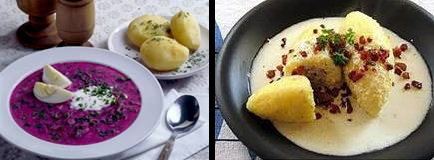
So often we hear something like this from people “I remember Sundays when I was a child. My mom would make cepelinai (potato dumplings filled with meat) and we would all gather around in the kitchen for this special meal”. Sadly what we also hear is “I have no idea how to make these traditional Lithuanian foods”.
- Bookmark :
- Digg
- del.icio.us
- Stumbleupon
- Redit it
Two Lithuanian dishes you simply have to try!
- Posted by - Comments (10)
|
|
|
So often we hear something like this from people “I remember Sundays when I was a child. My mom would make cepelinai (potato dumplings filled with meat) and we would all gather around in the kitchen for this special meal”. Sadly what we also hear is “I have no idea how to make these traditional Lithuanian foods”.
So, for those of you wanting to experience “true Lithuania” and wanting to remember the “good old days,” a few culinary musts are CEPELINAI, KUGELIS (potato pudding/cake) and ŠALTIBARŠČIAI (cold beetroot soup), accompanied of course by a glass of cold beer. Preferably Lithuanian beer.
Today we bring you the recipes for the šaltibarščiai and the cepelinai.
Now before I get into the recipes, it may be a good idea to explain why I was chosen to write this and other articles about preparing traditional Lithuanian food. I am not what you would call a great cook. With the exception of some amazing creativity with a barbecue, in the kitchen if I somehow prepare a marvelous meal it’s more a matter of luck rather than any amount of skill.
Some of the recipes may seem to be a little involved but actually they are not. All of the recipes I will give you are for meals I have prepared myself and I don’t mind one single bit telling you that they came out great!!! So the decision was made that if some one like me who needs to be supervised while in the kitchen so I don’t hurt myself can prepare these meals with success then I would be the best person to share these recipes with our dear readers. I’m sure that all of you will also meet with success when you prepare these traditional foods of Lithuania. After all, if I can do it...
ŠALTIBARŠČIAI
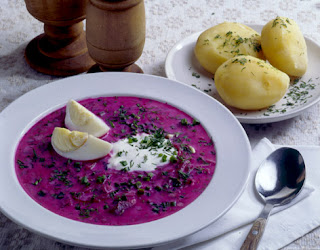
Here is what you will need:
2 good sized Beets
2 Cucumbers about 6 inches/15cm long (the smaller ones have more taste)
Sour cream
1 Liter/4 cups Sour Milk or Butter Milk
1 cup Boiled Water
8 sprigs of Fresh Dill – Finely Chopped
250 ml./1 Cup Scallion Greens or Chives - Finely Chopped
Salt and Pepper to taste
INITIAL PREPARATION:
Boil the beets for about 30 minutes.
After the beets cool enough so that they are comfortable to touch, peel off the skin.
Cut the beets into very thin strips – about 1/8 to 1/4 of an inch wide and 2 inches long. This can be a little time consuming so some people will coarsely grate them instead.
Hard boil the 2 eggs and allow to cool completely
Boil the 1 cup of water and then chill it (it should be COLD)
Finely slice the cucumbers
Crush the egg yokes
PREPARATION:
Add everything together. Add the Beets, Cucumbers, Milk, Scallion Greens/Chives, Boiled Water that is now Chilled, 100 gr./6 Tablespoons of Sour Cream, Salt and Pepper to taste and mix well.
Serve in individual bowls sprinkled with the Dill. The Egg Whites can be finely chopped and added to the mixture or you can get a little creative and finely slice them and put on the soup for decoration.
Traditionally ŠALTIBARŠČIAI is served with hot boiled potatoes as a side dish.
And don‘t forget the Lithuanian Black Bread
CEPELINAI
Recipes for traditional foods for all nationalities will all have their little “twists“ added in based on the region of the country or from one family to another. The recipes for many traditional Lithuanian foods are the same. The recipe for Cepelinai is like this. Based on what region your family is from or how your grandmother preferred to make them, you will find a difference with the amount of raw grated potatoes and boiled potatoes used.
The next question is what kind of potatoes should be used???
It’s best to use what is considered a “white” potato.
OK OK OK – now before some one says – What a moron this guy is, ALL potatoes are WHITE please allow me to elaborate :o)
As an example, don’t use Red potatoes and there is a variety called Yukon Gold which will give you an OK constancy but the color will have a strange yellow tint to it. I’ll need my friends in California to help me out on this one – Hey Sig and Rima, I understand that out on the West Coast there is a variety of potato that’s PURPLE??? Could you shed some light on this please? What works best are U.S. varieties such as Idaho and Maine potatoes. Our good friends in Canada have those wonderful P.E.I spuds and russet potatoes from your Prairie Provinces will work just fine. Here in Lithuania and Eastern Europe I honestly don’t know what the variety of potato is called here. I just use the potatoes that are not the Red potatoes (now you can maybe start to understand why I need supervision while I’m in the kitchen so I don’t hurt myself).
Here is the basic ratio for Grated to Cooked potatoes – For every pound/.5 Kg. of Potatoes use 2 average size Potatoes for the Cooked Potatoes.
POTATO PREPARATION
Peel 5 Lbs. of potatoes
Boil 8 average size potatoes
Grate the rest of the potatoes (apx. 4 Lbs.). When you grate the potatoes you need to use the side of the hand grater that has the SMALLEST holes if you want to get the correct constancy
In workable portions, place the grated potatoes in a doubled cheese cloth and squeeze dry.
Squeeze the liquid into a pan and let potato starch settle to the bottom. Carefully pour out the potato liquid and add the potato starch back into the grated potatoes.
Once the boiled potatoes have cooled a bit, put them into a ricer and then add to the grated potatoes and mix well. If you don’t have a ricer (I don’t) you can mash the boiled potatoes up with a potato masher and then add them to the grated potatoes and then mix VERY well. During the mixing add salt to taste.
MEAT STUFFING
The amount of meat depends on how much you use to fill each Cepelinas. It’s better to have some meat left over than run out so you may want to start with at least 600 gr./1.3 Lbs. of ground Pork.
Fry up a finely chopped onion and then add the ground pork and 2 teaspoons of Marjoram and cook until done. I may add that there is a spice mix called “Maltos Mėsos Prieskoniai” (Ground/Minced Meat Spices) that is sold in Lithuania and can be found in practically every kitchen in the country. It’s a blend of spices traditionally used in ground meat dishes including Celpelinai. It can be purchased at www.BalticValue.com
MAKING THE CEPELINAI
The amount of Potato and the amount of Meat used for each Cepelinas is something you just kind of figure out for yourself but to start with take about a half cup of the Potato mix (baseball/cricket ball size) and flatten it out. When you flatten it out it should be apx. a 6 inch/15 cm. circle ½ inch/1 cm. thick. Place 1-2 spoonfuls of the Meat filling in the center (apx. 1 inch/2 ½ cm. thick) and then roll the Potato mix around it and seal the edges and form into a small football (American football)/rugby ball. For me this is the most difficult part, trying to figure out how much Potato mix, how much Meat and then forming it all together but after 2-3 you get the hang of it.
Carefully put each Cepelinas into a large pot of salted boiling water. Some people put a spoonful of corn starch into the water to help keep the Cepelinai from falling apart. Boil 30 minutes and enjoy.
For toppings, some people enjoy a sauce made of fried bacon pieces and some enjoy Their Cepelinai with sour cream.
If this all sounds a little complex it really isn’t. It’s quite an easy meal to prepare. The most time consuming part is grating all the potatoes. In fact even with the people that are familiar with making dishes like Cepelinai and Kugelis that require A LOT of grated potatoes the reason they say that they don’t make these dishes more often is that it just takes so long to grate the potatoes.
Well a Lithuanian company has come to the rescue! There are a lot of kitchen machines on the market that do a lot of things but none of them actually grate potatoes to the consistency required for dishes like Cepelinai, Kugelis and Potato Pancakes to name a few. It figures that a Lithuanian company would understand what a machine needs to do to grate potatoes to the correct consistency. This machine which is known as the “Electric Potato Grater” has become an extremely popular item here in Lithuania because it is FAST!!! You can grate 10 Lbs/5 kg. of potatoes in minutes. For more information about this Electric Potato Grater you can go to www.BalticValue.com They have the machine in BOTH the 110 Volt and 220 Volt models and they ship all over the world.
Enjoy your Šaltibarščiai and enjoy your Cepelinai.
The next recipe will be for one of my personal favorites KUGELIS!!!
Skanaus – Vin Karnila
- Bookmark :
- Digg
- del.icio.us
- Stumbleupon
- Redit it
A beer drinking country
- Posted by - Comments (11)
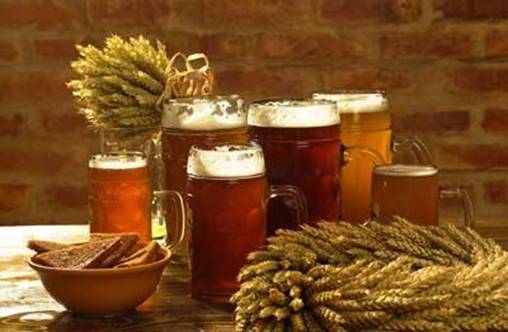
There are a number of things that make any Lithuanian swell with pride;
Rich History, Amber, Beautiful Nature, Basketball, etc.
There is, though, one that has a special place in their hearts. This source of pride is the Lithuanian Beer. Today, Lithuanians are among the best beer producers in the world, enjoying numerous international awards for the subtle taste and high quality of their drink. But is beer a truly “Lithuanian” drink and how deep are the traditions of brewing beer in Lithuania?
- Bookmark :
- Digg
- del.icio.us
- Stumbleupon
- Redit it
A beer drinking country
- Posted by - Comments (0)

There are a number of things that make any Lithuanian swell with pride;
Rich History, Amber, Beautiful Nature, Basketball, etc.
There is, though, one that has a special place in their hearts. This source of pride is the Lithuanian Beer. Today, Lithuanians are among the best beer producers in the world, enjoying numerous international awards for the subtle taste and high quality of their drink. But is beer a truly “Lithuanian” drink and how deep are the traditions of brewing beer in Lithuania?
- Bookmark :
- Digg
- del.icio.us
- Stumbleupon
- Redit it

A story from the page Juozo
philosophy
http://www.hbhjuozas.lt/?en=1103006956
This is one more area Lithuania has reason to be proud of. The Russians may disagree, as they claim to have started producing vodka in the 17th century. Lithuanians, however, claim that the Russians didn’t know how to make real vodka until the Russian chemist D. Mendeleev (1834-1907) discovered the process of the rectification of the alcohol. He also was the first, who suggested mixing alcohol and water according to the weight, and not volume, something not known to the manufacturers of the poor vodkas in Western Europe up till today.
In the old times, before this discovery, Russian villagers had a soured drink - "sivuha", "samagon", "brandahlist". The Ukrainians in the 17th century tried to learn how to distil vodka from the Lithuanians, but having no experience they distilled a whitish drink "gorilka", that kept all the alcohols and the water steam inside, and which contained about 25-30 per cent of alcohol. Most probably it was cheaper to buy vodka, which was brought by the Lithuanian merchants, than to make it. Knowledge and experience were needed for this.

BUT
In
Lithuania vodka, distilled from grain, was already being made at the beginning
of the millennium, just after year 1000!! A sour drink "gira", beer
and mead was made, but vodka was being distilled. The specially prepared barley
was being burnt (heated) so it by no means was boiled, but the vodka
evaporated. From this process vodka gets its Lithuanian name -
"DEGTINE" which comes from the verb “degti” (to burn). By the way,
this is the only term, describing the process of the production of the strong
drink. This linguistic-semantic argument is the most archaic in the world.
Whisky - means "water" in old English, eau de vie - "water"
in old French, vodka - "water" with a little bit negative meaning in
old common folk Russian. Ancient Lithuanians in their experience knew that
ethyl alcohol evaporates at the temperature of 78.3 degrees. Even now the very
good distillers of the home-made vodka determine and control the time of the
barley burning (heating), in order to get a “clear as a tear” home-made vodka,
without any additional smells (of other alcohols), dashes, and with the alcohol
percentage of 60-70. But vodka distillers knew that while distilling vodka, the
poisonous methyl alcohol exudes earlier at the temperature of 71 degrees. The
technologists of the modern vodka production, especially from Russia and
Europe, can not understand how Lithuanians could rectificate vodka, as the
rectification process itself was not known to the world yet.
It was a taboo for the distillers to drink the first dipper of vodka, which had to be, and still has to, be sacrificed to the gods by pouring vodka on the ground. This custom is still alive and obligatory in Lithuania. The first dipper of vodka can not be drunk. It is being poured over the shoulder, simultaneously saying "For Gods!" Up till now, in the villages of the Lowlands, You can hear the distillers saying in the Lowlandish dialect: "Give the first cup to the gods"; "Who does not give to gods, gets his eyes dripped"; "First cheers to gods, then to a person"; "First cheer the god, then god will give you health"; "Pour the first vodka to gods, if you do not do this, they will take your health away."
The most famous Irish and Scottish whiskey (whisky) manufacturers are deprived of speech when they hear such an elementary rectification dictated and learned by practice and experience. They incline their heads low, and award the Lithuanians with all the laurels. While the Irish, the first to start making whiskey in the British Isles, come straight to the point. They say that the beginning of whiskey and beer production, in the 13th century, was not spontaneous. It was started using the recipe, originally brought from somewhere, most probably from Lithuania.
"Trejos Devynerios"("Triple Nine") - the oldest bitter in the world

"Trejos Devynerios" is the bitter of 27 (9+9+9=27) herbs. In the old times it was made right after St. John’s night, at the sunrise. The herbs were collected in a way, known only to the priests (earlier - to the senior priests). Then the herbs were conformably dried, specially put together and infused with vodka (60% of alcohol) and distilled at that shortest night of the year. Only the priests could know the proportions. The ritual was always performed outside, for the bitter had to get the power and energy of the Sun. After the sun set, the bitter was poured into hornbeam barrels. Later on the barrels were poured over with the melted beeswax and buried in holes dug into the ground of the cellars. There the hermetically sealed bitter was kept for three years, three months, and three weeks.
In the 13-17th centuries, Lithuania was one of the biggest and the greatest countries in Europe, with its territory stretching from the Baltic till the Black Sea (including the present Belorussia, Ukraine, and Western Russia). The Grand Lithuanian Principality was often at war protecting Europe from the Tatar-Mongol hordes from the East. In the 13-17th centuries, having the most modern armaments in Europe, using the latest war tactics and strategies founded by the talented Lithuanian commanders, Lithuanians beat the Army of Batijus, and stopped their invasion into the Europe. Also for those long ages Lithuanians were fighting with the aggressive crusaders and sword bearing orders, holding off the onslaught of Lithuania from the West. The Lithuanian knights and warriors were using "Trejos Devynerios" as a universal remedy from cold and joint illnesses, as a disinfectant and a treatment means for war wounds, and also as a tonic for prophylactic. For Lithuanian men the greater part of their lives were spent in wars, so the healing bitter "Trejos Devynerios" was even included into the army list of food supplies from what is shown in the old Lithuanian army’s supply lists of the 15th century.
Six centuries later, in 1878, "Trejos Devynerios" showed up in the small German town of Welfenbüttel, just with a different name - "Jegermeister." After the German taste, it was much sweeter, but still there was a note on the label, that the recipe was received from Lithuanian monasteries. But when "Jegermeister" became famous in the rest of the world, the note, that the drink was being made according to the Lithuanian recipe, was not on the label any more. Anyway, there is still "Kreuter Mieke" in Germany. It is made out of herbs and it is used in the production of "Jegermeister." On the label of "Kreuter Mieke" there is a note stating that this is a mixture of 27 herbs after the original recipe of an old Lithuanian monastery.
In 1511, The Grand Duke of Lithuania Zygimantas the Senior allowed the merchants of Vilnius to buy and sell as much grain as they wanted freely, because a lot of grain was being used in the production of vodka, beer, and "gira" (a sour drink). Even the Guild of the Malters of Vilnius was founded. This guild sprouted, dried and ground the grain coarsely and sold it to everyone who wanted to make vodka and beer. This was legal, because during the period of the Grand Principality of Lithuania every inhabitant of Lithuania had a right to make mead or beer and to distil vodka for their own needs
The best homemade vodka from grain is believed to be distilled in the Lowlands in the Plunge district, and from rye - in Dzukija in the Varenos district and around Labanor. Officially this homemade vodka "Samane" is being produced by Alytus "Alita." This company is the only one in the world which does this.
"Starka" - thousand years old and probably a better drink than whisky

"Starka" is special festal vodka, which was traditionally made on the day of the birth of the first son. Already in the 15th century the foreigners, who were visiting Lithuania and describing its life, noticed the fact that when the midwife announced the birth of the son, men started distilling vodka. Later they poured that vodka into the oak barrel, which was later coated with the hot beeswax and dug into the ground. The barrel was being dug up, and the liquid tasted on the wedding day of that son, that means, at least about 20 years later. The name of this vodka is purely Lithuanian. It comes from the old Lithuanian word "starkus" (a stork), and this is connected with the widely spread story, that the new baby is being brought by the stork. And up to now countrymen are asking not for "Starka", but for "Starkine" vodka at the shop.
Though Russians are trying to explain that "starka" has come from the Russian word "staraya" (meaning "the old one"), if so the name of the vodka would be "Staraya", because, since the Russians learned to distil the potato-grain vodka after opening "Smirnoff" vodka factory, all Russian vodkas still have their original names: "Listovka", "Dovgan", "Spotykach", "Yerofeych", "Staromoskovskaya" and from Soviet times - "Moskovskaya", "Stolychnaya", "Russkaya", "Kubanskaya", "Sibirskaya.". In addition, from the linguistic side, the word "starka" has no semantic meaning in Russian.
Lithuanian mead is one of the oldest strong drinks in the world
Nowadays the only factory in the world "Lietuviskas midus" ("Lithuanian mead"), which is in a small Lithuanian town Stakliskes, produces Lithuanian mead of various kinds, according to recipes that are thousands of years old. Also here the especially strong and aromatic mead bitters (balsams) "Zalgiris" (70%), "Nemunas" (60%), "Suktinis" (50%), seasoned with herbs, are being made. These drinks are not only the most ancient of drinks with unique peculiarity in the whole world, they are peculiar only to Lithuania, and they could make Lithuania even more famous than for basketball if the Stakliskes folks would advertise themselves internationally.
Lithuanian "Krupnikas" - the most noble liqueur in Europe

This is the liqueur from honey and herbs, that was made by the monks of the Bernardine monastery, which was settled in Nesvyzius by M.K. Radvila Naslaitelis. The monks could see wine only on the tables of the dukes and the aristocracy.
In 1546, the wine cellars were built and equipped on Tiltu street in Vilnius. The wine supervisors had a home nearby. By the way, the costs of transporting the wine from Hungary made up to 65.3% of the wine’s price. The percentage was even higher, when the wine was brought from Avignon, or any other region of France, Southern German principalities, Italy - the Kingdom of Naples, Lombardy, Toscana, or the Pope’s wineries. Much wine was brought by the Hanza merchants. This wine was mostly being bought by the wine supervisors of the Vilnius’s Royal Palace. So, it goes without saying, that wine was being drunk only by the rich. The Bernardine monks, who came from the Southern parts of the Europe, were especially fascinated by mead - a not very strong drink, having the taste and aroma of the natural honey. On the base of this drink Bernardines created "Krupnikas." For the first time, the guests were officially treated to "Krupnikas"in 1593, on the occasion of the building of the NesvyZius Radvilos’ palace. This date should be considered the official date of the origin of Krupnikas. Of course, this date can not be related neither with the that is being made by "Vilniaus Degtine", nor with the drink of Kaunas’s "Stumbras." The real recipe of Krupnikas, which was created by the Bernardines, is different. It was known to the author, just as the other recipes of the ancient Lithuanian drinks. The author would agree to teach the recipe only to the Lithuanian Bernardines or the Kretinga Minorites because they had especially well conditions to make Krupnikas, but in no way he would teach the state or private companies.
The honey liqueur Krupnikas soon became the favourite drink of the aristocracy, and especially ladies liked it. Krupnikas became most famous after the 1920s, when Lithuanian independence was restored and when it became the most popular drink among the aristocrats of Kaunas. It was being served at feasts of the highest rank and governmental balls. At the Presidency and institutions, in the parsonages and estates, Krupnikas was being served in tiny, cut-glass decanters and drank from cups of the size of a thimble. It was drunk together with the coffee. Very often the estates, parsonages, and even the wealthier homes were making Krupnikas according to their own recipe. Krupnikas was being made out of everything at that time: cherry and lemon, orange and tangerine, badyan (a kind of anise) and cardamom, wine and champagne, montpensieur and brown sugar, but these were only primitive imitations that had nothing in common with the real Krupnikas.
At the same time the Polish started making their own "Krupnikas", but it was far from the original one. However, the Polish were justifiably proud of it. Because of this, some Lithuanians think that Krupnikas was created by the Polish in 1930.
Just do not forget that Lithuanian Krupnikas is the only liqueur in the world that is being warmed up before drinking. This is the way it was drunk by the monks and the nobles and only tasting krupnikas in this way can the marvellous, perfectly tuned honey, grain, alcohol and herbs taste and unique aroma open.
- Bookmark :
- Digg
- del.icio.us
- Stumbleupon
- Redit it
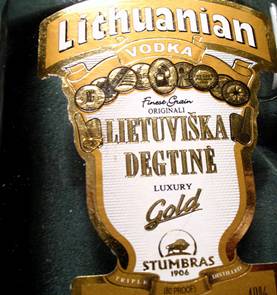
A story from the page “Juozo philosophy”
http://www.hbhjuozas.lt/?en=1103006956
This is one more area Lithuania has reason to be proud of. The Russians may disagree, as they claim to have started producing vodka in the 17th century. Lithuanians, however, claim that the Russians didn’t know how to make real vodka until the Russian chemist D. Mendeleev (1834-1907) discovered the process of the rectification of the alcohol. He also was the first, who suggested mixing alcohol and water according to the weight, and not volume, something not known to the manufacturers of the poor vodkas in Western Europe up till today.
- Bookmark :
- Digg
- del.icio.us
- Stumbleupon
- Redit it

Photo by Yours For Good Fermentables
I’m very excited to share this recipe with you because
KUGELIS IS MY ABSOLUTE FAVOURITE
Once again I have been elected to share a traditional Lithuanian recipe with you due to the fact that I am so very “culinary challenged”. Please remember that I need to be supervised when I’m in the kitchen so that I don’t hurt myself. But the powers to be of VilNews feel that I’m the best person to share these recipes since if a person with my limited cooking skills can cook these tasty meals than it shows to every one how easy they are to prepare.
- Bookmark :
- Digg
- del.icio.us
- Stumbleupon
- Redit it
VilNews e-magazine is published in Vilnius, Lithuania. Editor-in-Chief: Mr. Aage Myhre. Inquires to the editors: editor@VilNews.com.
Code of Ethics: See Section 2 – about VilNews. VilNews is not responsible for content on external links/web pages.
HOW TO ADVERTISE IN VILNEWS.
All content is copyrighted © 2011. UAB ‘VilNews’.

 Click on the buttons to open and read each of VilNews' 18 sub-sections
Click on the buttons to open and read each of VilNews' 18 sub-sections 









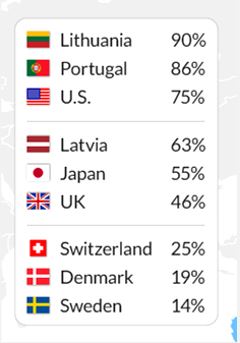
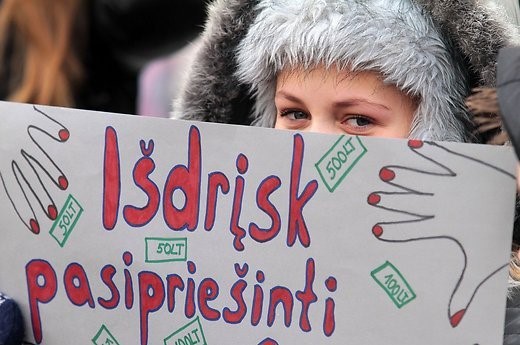


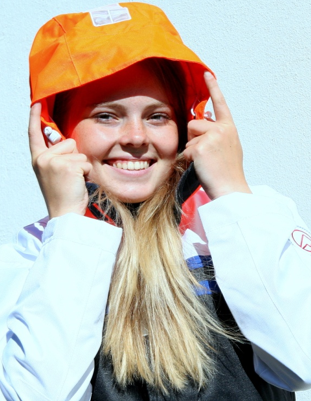



.jpg)
